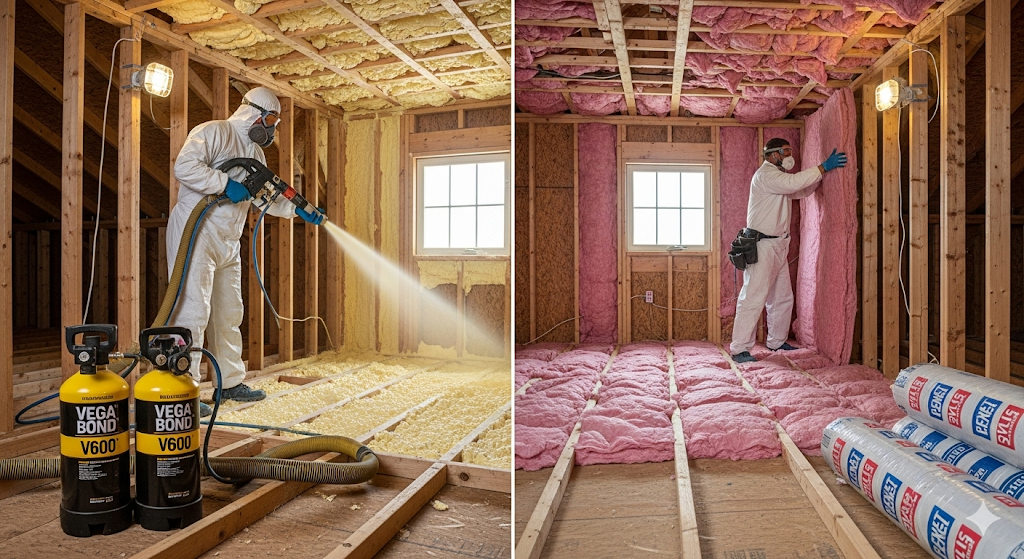When it comes to insulating your home or project space, the battle often comes down to spray foam insulation vs fiberglass insulation. Homeowners and builders want to know: Which one saves more money over time?
With rising energy bills and growing awareness of sustainable comfort, choosing the right insulation isn’t just about the upfront price, it's about performance, durability, and lifetime cost savings. In this guide, we’ll compare Vega Bond V600 closed cell spray foam insulation with traditional fiberglass across key categories like R-value, moisture resistance, air sealing, and long-term durability. By the end, you’ll know which one is the smarter investment for your project.
Key Takeaways
-
Vega Bond V600 closed cell spray foam delivers ~R-7 per inch, nearly double fiberglass insulation’s R-value.
-
Spray foam creates an airtight, moisture-resistant seal, while fiberglass leaves gaps that allow drafts and mold.
-
Fiberglass has lower upfront cost but degrades in 10–15 years; Vega Bond V600 lasts the building’s lifetime.
-
Long-term energy savings with Vega Bond V600 can cut heating and cooling bills by 30–50%.
Why Compare Vega Bond V600 and Fiberglass?
Fiberglass insulation has been the go-to option for decades because it’s affordable, widely available, and relatively easy to install. But traditional fiberglass has limits when it comes to air sealing, durability, and moisture resistance. On the other hand, spray foam insulation especially closed cell spray foam like Vega Bond V600 offers superior thermal protection, a tight seal against drafts, and long-lasting performance.
The question most homeowners ask is: Does the higher upfront cost of spray foam truly pay off compared to fiberglass?
Let’s break it down with real comparisons.
R-Value Comparison: Vega Bond V600 vs. Fiberglass
The R-value measures how well insulation resists heat flow. A higher R-value means better energy efficiency and comfort. This is one of the most important factors in deciding which insulation performs best.
-
Vega Bond V600 Closed Cell Spray Foam delivers around R-7 per inch, nearly twice as effective as fiberglass. For a full breakdown of its technical specs and performance, see our detailed overview.”. Its density means you can achieve high insulation levels without needing excessive thickness.
-
Fiberglass Batt Insulation: Typically R-2.9 to R-3.8 per inch, meaning you’ll need much more material (and space) to reach the same insulating power.
This difference is critical in areas like attics, crawl spaces, or basements where space is limited. Choosing a material with a higher R-value per inch means you get superior insulation even in tight spots.
Comparison Table: Vega Bond V600 vs Fiberglass
|
Feature |
Vega Bond V600 (Closed Cell Spray Foam) |
Traditional Fiberglass |
|
R-Value per Inch |
~R-7 (very high) |
~R-3 (moderate) |
|
Air Sealing |
Creates an airtight seal |
Leaves gaps and air leaks |
|
Moisture Resistance |
Blocks moisture, prevents mold |
Absorbs moisture, mold risk |
|
Durability |
Lasts the building’s lifetime |
Can sag, settle, and lose effectiveness in 10–15 years |
|
Installation Cost |
Higher upfront cost |
Lower upfront cost |
|
Energy Efficiency |
Cuts heating and cooling bills by 30–50% |
Limited savings; leaks reduce efficiency |
|
Best Use Cases |
Basements, crawl spaces, attics, whole-house upgrades |
Attics, walls, large open areas with fewer moisture risks |
Quick Insight: Vega Bond V600 is an investment in efficiency and comfort, while fiberglass is a basic, budget-friendly option with limited long-term benefits.
Air Sealing and Moisture Resistance

Air leaks and moisture infiltration are hidden problems that can quietly increase your energy bills and create long-term damage. Even if fiberglass has a decent R-value, it doesn’t seal air gaps
-
Fiberglass: Tends to leave gaps around studs, wiring, and framing. These gaps allow air to flow through, causing drafts and temperature fluctuations. Over time, fiberglass can also absorb moisture, leading to mold and mildew growth.
-
Vega Bond V600: Expands during application to fill every crack and crevice, forming an airtight barrier. It also has a closed cell structure that repels water, keeping your walls dry and safe from mold.
This combination of air sealing + moisture resistance makes Vega Bond V600 the clear winner for basements, crawl spaces, and humid climates where fiberglass simply cannot compete.
Installation Cost vs. Long-Term Durability
The upfront installation cost is one of the biggest differences between fiberglass and spray foam. Fiberglass is cheaper to purchase and install, which is why many homeowners still choose it. But cost should always be measured against long-term durability.

-
Fiberglass: Lower installation cost, but it doesn’t last as long. It can settle, compress, or shift out of place. After 10–15 years, performance drops and replacement may be needed.
-
Vega Bond V600: Costs more per board foot upfront (closed cell spray foam cost per board foot is around $1.00–$1.50 installed), but it doesn’t sag or degrade. Once applied, it can last the lifetime of your building.
Over decades, fiberglass’s lower upfront cost is overshadowed by higher energy bills and replacement expenses. Vega Bond V600, on the other hand, saves money long-term by cutting heating and cooling costs and eliminating replacement cycles.
How Much Does Foam Spray Insulation Cost?
A frequent question is “how much does foam spray insulation cost compared to fiberglass?”
-
Closed Cell Spray Foam (like Vega Bond V600): $1.00–$1.50 per board foot installed.
-
Fiberglass: Around $0.50–$1.00 per square foot installed.
At first glance, fiberglass appears cheaper. But consider this: spray foam typically reduces heating and cooling bills by up to 40%, and it lasts decades longer. That’s why spray foam is considered a lifetime investment rather than a short-term fix.
See current pricing for Vega Bond V600 here.
Comfort and Energy Efficiency in Real Life
Comfort is where the benefits of Vega Bond V600 truly shine.
-
Fiberglass: Homeowners often report cold drafts in winter and hot spots in summer. It slows heat transfer but doesn’t prevent air movement.
-
Vega Bond V600: By creating a seamless barrier, spray foam eliminates drafts and stabilizes indoor temperatures. Learn how to spray foam an attic for better insulation results.
The result is not only lower heating and cooling bills but also a home that feels consistently comfortable, quiet, and energy-efficient year-round.
Where Each Insulation Works Best
- Fiberglass Insulation Works Best For:
- Large, open areas where cost is the primary concern
- Attics or walls where thickness isn’t a problem
- Short-term projects where long-term durability isn’t a priority
Vega Bond V600 Spray Foam Works Best For:
- Basements, crawl spaces, and tight areas where moisture is a risk. See how it compares in our guide on the best spray foam insulation.
- Whole-home insulation projects where long-term durability matters
-
DIY homeowners and light commercial users who want lasting comfort and savings
FAQs:
What’s the main difference between Vega Bond V600 and traditional fiberglass insulation?
The main difference is performance. Vega Bond V600 offers higher R-value per inch, better air sealing, and moisture resistance, while fiberglass is limited to slowing heat transfer without sealing gaps.
Is spray foam more expensive than fiberglass?
Yes, the upfront cost of spray foam insulation is higher. But the insulation cost savings from lower energy bills and long-term durability make Vega Bond V600 more affordable over the life of your home.
Can I install Vega Bond V600 myself, or do I need a professional?
You can install Vega Bond V600 as a DIY project with the right kit and safety equipment. However, for large jobs, hiring a professional ensures consistent coverage and compliance with building codes.
How does Vega Bond V600 improve comfort inside my home?
By sealing air leaks and boosting R-value, Vega Bond V600 eliminates drafts, keeps temperatures consistent, and even reduces outside noise. The result is superior year-round comfort.
What’s the R-value of Vega Bond V600 compared to fiberglass?
-
Vega Bond V600: R-7 per inch
-
Fiberglass: R-3 per inch
This means you need nearly twice the fiberglass thickness to equal spray foam’s performance.
Will Vega Bond V600 help with mold or moisture issues?
Yes. Its closed cell design repels water and prevents mold and mildew growth, unlike fiberglass which can absorb moisture.
How long does Vega Bond V600 last compared to fiberglass?
Fiberglass lasts 10–15 years before sagging or breaking down. Vega Bond V600 can last the lifetime of your building with no loss in performance.
Is Vega Bond V600 safe to use in small projects or workshops?
Yes. It’s widely used by DIY homeowners and fabricators for garages, workshops, and basements. Just follow safety precautions during application.
Why choose Vega Bond V600 over cheaper spray foams?
Cheaper open-cell foams have lower density and weaker moisture resistance. Vega Bond V600 offers superior R-value, durability, and long-term cost savings.
Does Vega Bond V600 increase property value?
Yes. Homes with energy-efficient insulation and lower heating/cooling costs are more appealing to buyers. Spray foam can increase resale value by making your property stand out.



